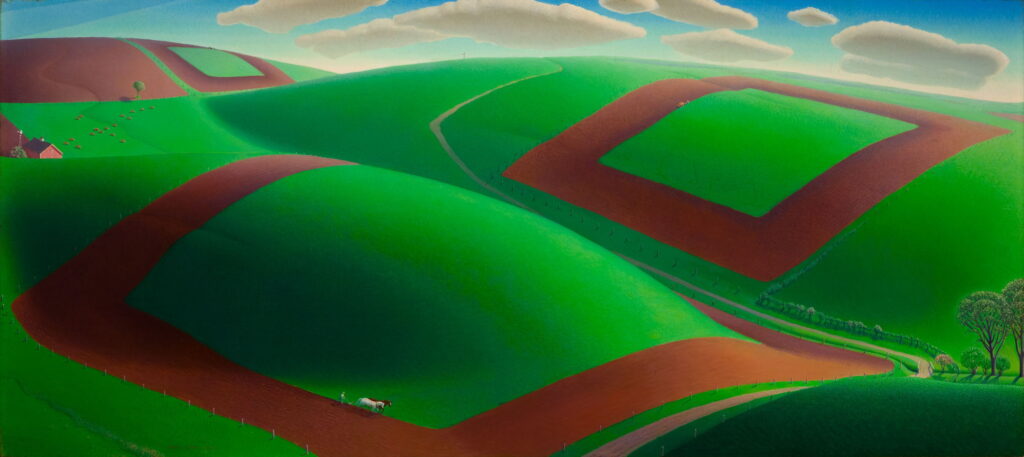A to Z of Landscapes: Uplands

When landscape artists take to the hills, they often head for rocky peaks and miss the undulating uplands of the foothills. So u in this alphabet of landscapes stands for those undulating uplands that roll rather than precipitate. In English they’re often referred to as downs, which might appear contradictory, although the word has common origins with dunes, which makes more sense, perhaps.
Samuel Palmer (1805-1881), The Weald of Kent (c 1833-4), watercolour and body-colour, 18.7 x 27.1 cm, Yale Center for British Art, New Haven, CT. Wikimedia Commons.
Samuel Palmer’s view of The Weald of Kent from about 1833-34 is typical of what you see looking down from a ridge at the valley below. This is an area of low hills between the main South and North Downs in the south-east of England.
Arnold Böcklin (1827–1901), In the Alban Hills (1851), oil on canvas, 57 x 77 cm, Staatliche Kunsthalle Karlsruhe, Karlsruhe, Germany. Wikimedia Commons.
Although a bit more rugged than the Downs of England, Arnold Böcklin’s view In the Alban Hills from 1851 shows these hills about 20 km (12 miles) south-east of the city of Rome. These have long been a popular escape from the city during the hot months of summer.
Jean-François Millet (1814–1875), The Hamlet of Cousin near Gréville (1855), oil on canvas, 71.5 × 91.5 cm, Musée des beaux-arts de Reims, Reims, France. Wikimedia Commons.
Jean-François Millet returned to the rolling Normandy countryside of his birth in The Hamlet of Cousin near Gréville (1855). This shows the rough lane leading to another nearby hamlet, Cousin, amid rolling countryside with hedgerows enclosing tiny fields.
Benjamin Williams Leader (1831–1923), A Welsh Cornfield (1862), oil on canvas, dimensions and location not known. Wikimedia Commons.
Benjamin Williams Leader found A Welsh Cornfield in 1862 with its cereal crop cut by hand into stooks ready for threshing. One of the women is using a ladder stile to traverse the field’s dry stone wall. There’s fine attention to detail, including appropriate native plants, in accordance with the principles of Pre-Raphaelite landscape painting.
Camille Pissarro (1830–1903), Côte de Jalais, Pontoise (1867), oil on canvas, 87 x 114.9 cm, Metropolitan Museum of Art, New York, NY. Wikimedia Commons.
Camille Pissarro’s Côte de Jalais, Pontoise (1867) shows the hill of Les Jalais at l’Hermitage, where Pissarro lived, viewed from the Chemin des Mathurins in Pontoise, north of Paris.
Ivan Pokhitonov (1850–1923), The Walloon Village of Jupille (1912), oil on panel, 20.5 x 26 cm, location not known. Wikimedia Commons.
When Ivan Pokhitonov was living in Belgium in 1912, he painted this view of The Walloon Village of Jupille, catching its fruit trees in blossom.
Eugène Burnand (1850–1921), Ploughing in the Jorat (1916), oil on canvas, 270 x 620 cm, location not known. Wikimedia Commons.
In 1915 Eugène Burnand painted his last major work, Ploughing in the Jorat, but his first version was destroyed by fire. He completed this second version the following year. This wide-screen pastoral landscape contains a patchwork of villages and farmland between forested hills, near where the artist lived, to the north of Lausanne in Switzerland.
Paul Nash (1892–1946), Cotswold Hills (c 1920), oil on canvas, 49.1 x 59.2 cm, Plymouth Museum and Art Gallery, Plymouth, England. The Athenaeum.
Paul Nash’s view of the Cotswold Hills, from about 1920, shows the rolling countryside near his family home in Buckinghamshire, England. These hills sprawl across a large tract of central western England, to the west of Oxford.
Grant Wood (1891–1942), Spring Turning (1936), oil on Masonite, 46.4 x 101.9 cm, Reynolda House Museum of American Art, Winston-Salem, NC. Wikimedia Commons.
Grant Wood’s Spring Turning from 1936 is a high aerial view of rolling countryside in the American rural Midwest, being ploughed using a pair of horses, during the Spring. Its bright green fields seem almost endless.
Eric Ravilious (1903–1942), The Vale of the White Horse (c 1939), graphite and watercolour on paper, 45.1 × 32.4 cm, The Tate Gallery (Purchased 1940), London. © The Tate Gallery and Photographic Rights © Tate (2017), CC-BY-NC-ND 3.0 (Unported), https://www.tate.org.uk/art/artworks/ravilious-the-vale-of-the-white-horse-n05164
Around 1939, shortly before the start of the Second World War, Eric Ravilious visited the famous White Horse cut in the chalk downs at Uffington in Berkshire, England. The Vale of the White Horse (c 1939) shows the view from an unconventionally low angle, in pouring rain. This hill figure is thought to date from the late Bronze or early Iron Age, around three millennia ago.
Percy Shakespeare (1906–1943), December on the Downs, Wartime (c 1939-44), oil on canvas, 62.5 x 92.5 cm, location not known. Wikimedia Commons.
Percy Shakespeare’s painting of December on the Downs, Wartime, made during the Second World War, shows one of the rolling chalk downs in the south of England, with both tractors and teams of horses working the land.


